 W
WThe Barbary pirates, or Barbary corsairs or Ottoman corsairs, were Muslim pirates and privateers who operated from North Africa, based primarily in the ports of Salé, Rabat, Algiers, Tunis, and Tripoli. This area was known in Europe as the Barbary Coast, in reference to the Berbers. Their predation extended throughout the Mediterranean, south along West Africa's Atlantic seaboard and into the North Atlantic as far north as Iceland, but they primarily operated in the western Mediterranean. In addition to seizing merchant ships, they engaged in Razzias, raids on European coastal towns and villages, mainly in Italy, France, Spain, and Portugal, but also in the British Isles, the Netherlands, and Iceland. The main purpose of their attacks was slaves for the Ottoman slave trade as well as the general Arab slavery market in North Africa and the Middle East. Slaves in Barbary could be of many ethnicities, and of many different religions, such as Christian, Jewish, or Muslim.
 W
WThe action of 28 November 1751 was a naval engagement off Cape St. Vincent between a squadron of two Spanish ships of the line under captain Pedro Fitz-James Stuart and an Algerine squadron of two ships of the line under corsair Mohammed Chirif, which was fought from November 28 to December 2, 1751 and resulted in a victory for the Spanish fleet. The Algerine ships had come from the port of Algiers, and were acting as corsairs, conducting commerce raiding against Christian merchant ships and enslaving their crews. This was part of the Barbary slave trade, where the Barbary states, autonomous vassals of the Ottoman Empire raided Christian settlements and merchant vessels for slaves to sell in their own cities. The corsairs targeted Spain, a Christian country, and the Spanish Navy was sent to track down the formidable Algerine force of two ships of the line, which posed a significant threat to any Christian vessels in the region. When the fleets sighted each other on November 28, 1751, they found that they were evenly matched with their opposition; both fielded two ships of the line.
 W
WThe Algerian popular resistance against French invasion is the historic process that the Algerian people undertook to counter the invasion of French colonial troops on Algerian soil.
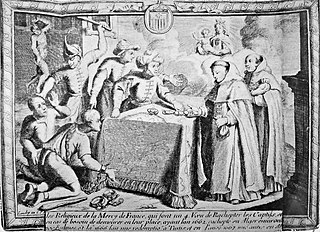 W
WAnglo-Turkish piracy or the Anglo-Barbary piracy refers to the collaboration between Barbary pirates and English pirates against Catholic shipping during the 17th century.
 W
WBaba Ali Chaouch, also written as Baba Ali Chaouche, or simply Ali I, was the first independent ruler of the Deylik of Algiers who ruled from 1710 to 1718.
 W
WHayreddin Barbarossa, also known as Hızır Hayrettin Pasha, and simply Hızır Reis , was an Ottoman corsair and later admiral of the Ottoman Navy. Barbarossa's naval victories secured Ottoman dominance over the Mediterranean during the mid 16th century.
 W
WThe Barbary slave trade refers to slave markets on the Barbary Coast of North Africa, which included the Ottoman states of Algeria, Tunisia and Tripolitania and the independent sultanate of Morocco, between the 16th and 19th century. The Ottoman states in North Africa were nominally under Ottoman suzerainty, but in reality they were quasi-independent.
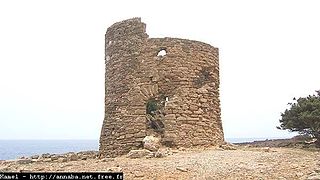 W
WThe Bastion de France was a trading post founded in the sixteenth century by French merchants of Corsican origin who had established themselves in North Africa near Annaba. It developed important commercial links with Marseille, especially in the valuable coral trade. It was demolished and rebuilt a number of times.
 W
WThe bombardment of Algiers in 1682 was a naval operation by France against the Regency of Algiers during the French-Algerian War of 1681–88. Louis XIV sent Duquesne to bombard Algiers after the Dey declared war on France in 1681. Duquesne sailed from Toulon with a fleet of around forty vessels and reached Algiers in July 1682 after many delays caused by poor weather. Bombarded several times in August, the city suffered extensive damage. The peace which the Dey was eventually forced to seek was however never agreed, as renewed bad weather forced Duquesne to retreat to French waters.
 W
WThe bombardment of Algiers in 1683 was a French naval operation against the Regency of Algiers during the French-Algerian War 1681–88. It led to the rescue of more than 100 French prisoners, in some cases after decades of captivity, but the great majority of Christian captives in Algiers were not liberated.
 W
WThe bombardment of Algiers in 1688 was a military expedition ordered by Louis XIV against the Regency of Algiers in order to enforce the peace treaty of 1683 which had been violated by Algerian pirates. The squadron, comprising 31 ships and 10 bomb galiots, was commanded by Jean II d'Estrées.
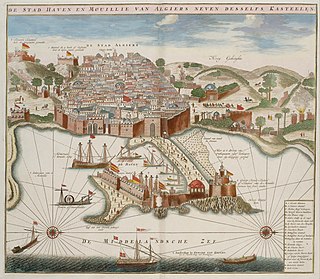 W
WThe 2nd Bombardment of Algiers took place between 12 and 21 July 1784. A joint Spanish-Neapolitan-Maltese-Portuguese fleet commanded by the experienced Spanish Admiral Antonio Barceló bombarded the city, which was the main base of the Barbary corsairs, with the aim of forcing them to interrupt their activities. Massive damage and casualties were inflicted to the Algerians, while the loss aboard the allied fleet was low. The Dey of Algiers refused to start negotiations immediately but the fear of a third planned expedition under José de Mazarredo convinced him to negotiate a peace with the Spanish by which he was forced to cease large-scale piracy, signalling the effective end of the Barbary privateering until the outbreak of the Napoleonic Wars.
 W
WOn 18–19 December 1669, a battle took place in the waters near Cádiz between the English fourth-rate frigate Mary Rose under the command of Rear-Admiral John Kempthorne, escorting several merchantmen, and a group of seven pirate ships operating out of Algiers. The incident was recorded and drawn by the engraver Wenceslaus Hollar, with an engraving appearing in John Ogilby's Africa.
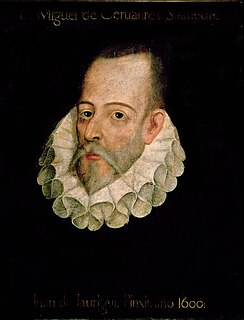 W
WMiguel de Cervantes Saavedra was a Spanish writer widely regarded as the greatest writer in the Spanish language and one of the world's pre-eminent novelists. He is best known for his novel Don Quixote, a work often cited as both the first modern novel and one of the pinnacles of world literature.
 W
WAngelo Emo was a Venetian noble and admiral, mostly known for being the last admiral of the Republic of Venice to lead the Venetian navy to battle. He attempted to introduce reforms based on the practices of the British Royal Navy, and led raids on Moorish targets along the Barbary Coast in retaliation for corsair attacks on Venetian-flagged shipping.
 W
WThe European enclaves in North Africa were towns, fortifications and trading posts on the Mediterranean and Atlantic coasts of western North Africa, obtained by various European powers in the period before they had the military capacity to occupy the interior. The earliest of these were established in the 11th century CE by the Italian Maritime republics; Spain and Portugal were the main European powers involved; both France and, briefly, England also had a presence. Most of these enclaves had been evacuated by the late 18th century, and today only the Spanish possessions of Ceuta, Melilla, and the Plazas de soberanía remain.
 W
WThe French-Algerian War 1681-1688 was part of a wider campaign by France against the Barbary Pirates in the 1680s.
 W
WThe French-Tripolitania War (1681-1685) was part of a wider campaign by France against the Barbary Pirates in the 1680s.
 W
WHamidou ben Ali, known as Raïs Hamidou, or Amidon in American literature, born around 1770 in Algiers, and died on June 17, 1815, near Cape Gata, was an Algerian privateer. He captured up to 200 ships during his career. Hamidou ensured the prosperity of the Deylik of Algiers, and gave it its last glory before the French invasion. His biography is relatively well known because the French archivist Albert Devoulx has found important documents, including a precious register of prizes opened by the authorities of the Deylik in 1765. Songs and legends have also taken hold of this charismatic character.
 W
WThomas Hees was a Dutch diplomat, active in the negotiations of the States General with the corsairs of Barbary. He is mostly known through his famous portrait but also thanks to the journal which he kept during his first mission in Algiers.
 W
WLundy is an English island in the Bristol Channel. It forms part of the district of Torridge in the county of Devon.
 W
WOruç Reis was an Ottoman seaman, who became bey (governor) of Algiers, beylerbey of the West Mediterranean, and admiral of the Ottoman Empire. The elder brother of the famous Ottoman admiral Hayreddin Barbarossa, he was born on the Ottoman island of Midilli and died in battle against the Spanish at Tlemcen in the Ottoman Eyalet of Algeria.
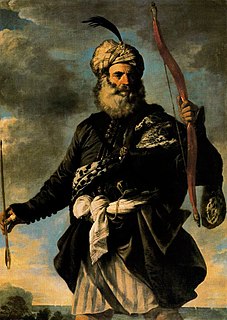 W
WThe Salé Rovers, also Sale Rovers or Salle Rovers, were a dreaded band of Barbary corsairs in the 17th century. They formed the Republic of Salé on the Moroccan coast. The most famous of the rovers was Jan Janszoon, a Dutchman who had been a pirate for Holland in the Mediterranean. He "turned Turk" after being captured by one of the Moorish states in 1618 and became known as Admiral Murat Reis.
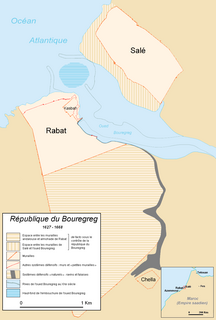 W
WThe Republic of Salé was a short-lived city state at Salé, during the 17th century. Located at the mouth of the Bou Regreg river, it was founded by Moriscos from the town of Hornachos, in Western Spain. Moriscos were the descendants of Muslims who were nominally converted to Christianity, and were subject to mass deportation during the Spanish Inquisition. The Republic's main commercial activities were the Barbary slave trade and piracy during its brief existence in the 17th century. The city is now part of the Kingdom of Morocco.
 W
WSinan Reis, also Ciphut Sinan, "Sinan the Chief", and Portuguese: Sinão o Judeo, "Sinan the Jew", was a Barbary corsair and Jewish pirate who sailed under the famed Ottoman admiral Hayreddin Barbarossa.
 W
WThe Spanish conquest of Oran and Mers el-Kebir took place from 15 June to 2 July 1732, between the Kingdom of Spain and the Deylik of Algiers. The great Spanish expedition led by Don José Carrillo de Albornoz, Duke of Montemar and Don Francisco Javier Cornejo defeated the Algerian troops under the command of the Bey of the Beylik of Oran, Mustapha Bouchelaghem, and the Wali of Oran, Hassan. It successfully conquered the fortress-cities of Oran and Mers el-Kebir, ruled and administered by Algiers from 1708, during the War of the Spanish Succession, when both cities were conquered by the aforementioned Bouchelaghem, who was the governor of the western regions of Algiers.
 W
WThe Turkish Abductions were a series of slave raids by pirates from Northwest Africa that took place in Iceland in the summer of 1627. The pirates came from the cities of Algiers and Salé. They raided Grindavík, the East Fjords, and Vestmannaeyjar. About 50 people were killed and close to 400 people were captured and sold in the African slave market. A ransom was eventually paid, 9 to 18 years later, for the return of 50 individuals.
 W
WThe bombardments of the Beylik of Tunis were a series of Venetian naval bombardments of the capital and various cities of the Beylik of Tunis in order to force Bey Hammuda ibn Ali to stop supporting the pirates that harassed the trade routes of Venice. The campaign lasted four years, during which the Venetian fleet at the orders of Angelo Emo greatly increased in both number and power.